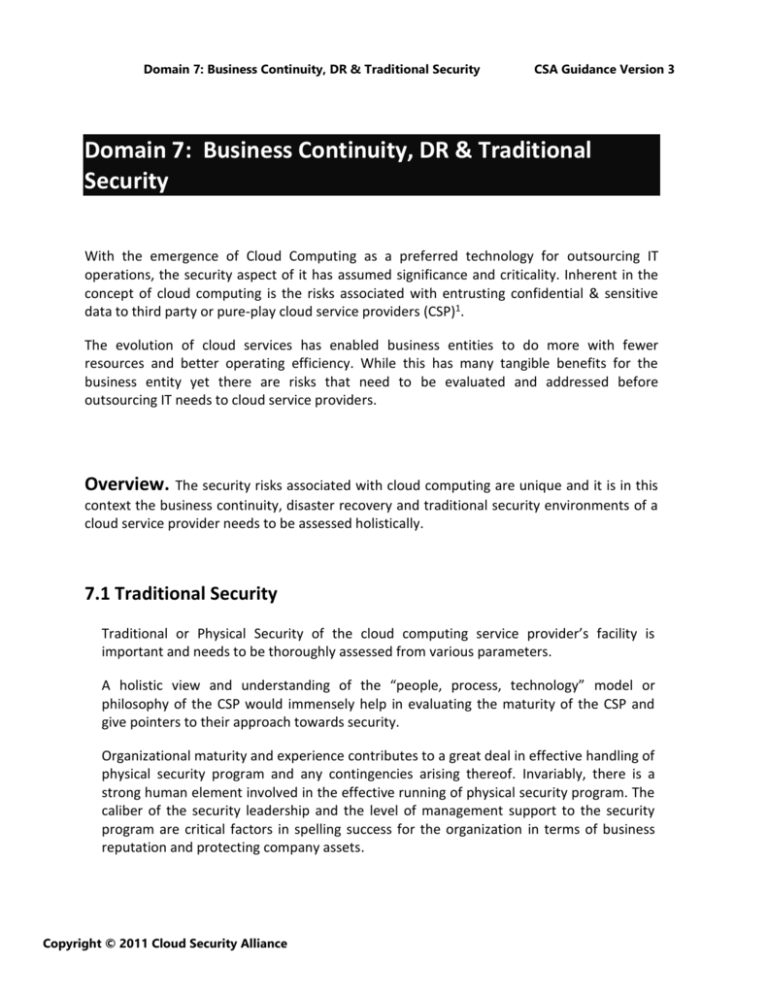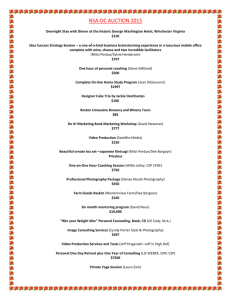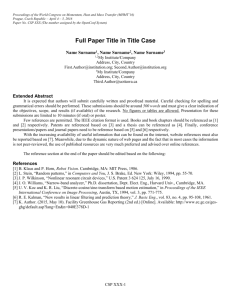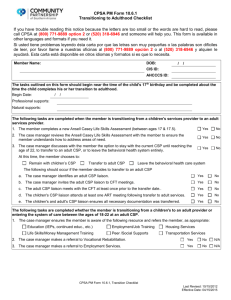Domain 7: Business Continuity, DR
advertisement

Domain 7: Business Continuity, DR & Traditional Security CSA Guidance Version 3 Domain 7: Business Continuity, DR & Traditional Security With the emergence of Cloud Computing as a preferred technology for outsourcing IT operations, the security aspect of it has assumed significance and criticality. Inherent in the concept of cloud computing is the risks associated with entrusting confidential & sensitive data to third party or pure-play cloud service providers (CSP)1. The evolution of cloud services has enabled business entities to do more with fewer resources and better operating efficiency. While this has many tangible benefits for the business entity yet there are risks that need to be evaluated and addressed before outsourcing IT needs to cloud service providers. Overview. The security risks associated with cloud computing are unique and it is in this context the business continuity, disaster recovery and traditional security environments of a cloud service provider needs to be assessed holistically. 7.1 Traditional Security Traditional or Physical Security of the cloud computing service provider’s facility is important and needs to be thoroughly assessed from various parameters. A holistic view and understanding of the “people, process, technology” model or philosophy of the CSP would immensely help in evaluating the maturity of the CSP and give pointers to their approach towards security. Organizational maturity and experience contributes to a great deal in effective handling of physical security program and any contingencies arising thereof. Invariably, there is a strong human element involved in the effective running of physical security program. The caliber of the security leadership and the level of management support to the security program are critical factors in spelling success for the organization in terms of business reputation and protecting company assets. Copyright © 2011 Cloud Security Alliance Domain 7: Business Continuity, DR & Traditional Security CSA Guidance Version 3 As you are aware, physical security is generally the first line of defense against unauthorized access to an organization’s physical assets and the physical theft of records. 7.2 Recommendations o Onsite visit to the CSP’s facility or data center would help in performing an on-thespot assessment and have a clear understanding of the different security measures that have been put in place. o To enhance effectiveness of the onsite assessment, the visit to the CSP facility or data center should be carried out unannounced (if need be with the CSP being informed about a broad time window rather than specific times). This will enable to have real assessment on the ground on a normal business day instead of giving an opportunity to the CSP to ‘keep up appearances’ during a client visit. o The assessment team should comprise at least 2 members or more with specialists drawn from IT, Information Security, Business Continuity, Physical Security and Management functions. 7.3 Requirements While evaluating the traditional security of a CSP, please do consider the following aspects: Physical Location of the CSP Facility Check if the location of the facility falls under any active seismic zone and the risks thereof. Facility should not be located in a geographic region which is prone to: Flooding, landslides or other natural disasters Political, ethnic, communal or social unrests Easy and quick accessibility of the facility’s location Documentation Review Physical & Environmental Security Policy User Account Termination Procedures Contingency Plan Incident Reporting & Response Plan Emergency Response Plan Copyright © 2011 Cloud Security Alliance Domain 7: Business Continuity, DR & Traditional Security CSA Guidance Version 3 Facility Layout – emergency exits, positioning of CCTV cameras, secure entry points Fire Exit Route Map & Fire Order Instructions Emergency Evacuation Plan & Procedures Crisis Communication Procedures Emergency Contact Numbers User Facility Access Review/Audit Records Security Awareness Training documentation, presentation, handouts, etc Security Awareness Attendance Records Succession Planning for key executives Technical Documents – electrical wiring diagrams, BMS, UPS, AHU details Maintenance Schedule of Electrical, Generator & CCTV List of Authorized Personnel allowed entry inside facility Security Staff profiles – bio & background information Background Check Reports of Security Staff (must be performed every year) Annual Maintenance Contracts for key equipments & devices (focus on SLAs for equipment/devices downtime & restoration) Check whether all the documents are updated and current. The documents must be reviewed by the CSP at least once in a year. The revision dates and sign off from competent employees must be mentioned in all the documentation as proof of them being reviewed internally. Further, the policy and procedure documents (that are suitable for employee viewing) should be made available through a common Intranet site where authorized employees of the CSP can access them anytime for reference. Adequate care must be taken by the security team to ensure the uploaded documents are the latest versions duly approved by the management. All policies and procedures would be effective only when employees are aware of them. To this effect, check whether the CSP has security awareness program in place. At the minimum, the CSP should ensure that employees are given adequate security awareness training at least once a year and receive sign off from them. Also, new employees joining the organization shall undergo a security orientation session as part of the induction program where key policies and procedures are to be covered. To make the program effective, a senior staff from the security team must conduct the session. Compliance with International/Industry Standards on Security If the CSP is compliant with global security standards like ISO 27001 ISMS or any other industry-specific standard it would be helpful in assessing the level of security program and its maturity. Copyright © 2011 Cloud Security Alliance Domain 7: Business Continuity, DR & Traditional Security CSA Guidance Version 3 Verify the compliance certificate and its validity. Look for verifiable evidence of resources allocation – budget and manpower to sustain the compliance program. Verify internal audit reports and evidence of remedial actions for the findings. Visual Walk Through Inspection of the CSP’s facility Area Coverage Perimeter security Data Center Administrative areas Reception Parking Area Storage Area Fire Exits CCTV Command Center AHU Room Locker Room UPS Room Generator Room Fuel Storage Tanks Signages Look out for the following signages that must be displayed prominently in the facility at appropriate places: Fire Escape Route Maps & Emergency Exits Fire Order Instructions Fire Safety Signages Security Posters & Instructions Anti-tailgating Posters Temperature/Humidity-related information Warning & Instructional Signages Emergency Contact Numbers Escalation Chart Security Infrastructure Perimeter security is important as it serves as the first line of protection against intruders and unwanted visitors. The principles of perimeter security has undergone sea change Copyright © 2011 Cloud Security Alliance Domain 7: Business Continuity, DR & Traditional Security CSA Guidance Version 3 with technological advancements. The Four D’s of Perimeter Security consists of Deter, Detect, Delay and Deny phases for intruders wanting access to the facility. At the minimum, the following security infrastructure must be available at the CSP’s facility. Due care must be taken to ensure the infrastructure is adequate vis-à-vis the facility’s size and nature & scale of operations, strategically positioned and conforms to acceptable quality standards consistent with prevalent norms and best practices. Secure Entry Points – Access control systems (proximity cards/biometric access) Access Control System linked with fire control panel for emergency release Emergency auto-release buttons near all access card readers Motion-sensing alarms, thermal tracking devices Fire Safety Equipments – Wet Riser, Hydrants, Hoses, Smoke Detectors & Water Sprinklers Fire Extinguishers Fire Exits (must not be locked) Panic Bars in fire exit doors Alarm Hooters CCTV Cameras and DVR server (including backup timelines) Door Closures and time-delay door alarms Gas-based fire suppressants inside Data Centers Paper Shredders near printers Emergency Response Team Kit (ERT Kit) Two-way Radio devices (Walkie-talkie handsets) for security staff Duress Alarms underneath security desk and vantage (concealed) points Door Frame Metal Detectors at entrance & Hand-held Metal Detectors (if needed) Fire-proof Safe to safe keep important documents/media Human Resources Security Competent Security Personnel Check to see if the CSP deploys competent security personnel for its physical security function. A dedicated security manager is highly recommended to provide the necessary leadership and drive to the physical security program. Leading industry certifications like CPP (from ASIS) would be helpful in validating the incumbent’s knowledge & skills in physical security. A careful scrutiny of the reporting structure of the security manager would help in determining whether the position has been given due significance it deserves. Ideally, the security manager should report to a functional superior and not to any other Copyright © 2011 Cloud Security Alliance Domain 7: Business Continuity, DR & Traditional Security CSA Guidance Version 3 department like Facilities or IT. Better still, if the position reports to the CEO directly it would be better in terms of independence and objectivity of the position. Training Check to see if the CSP’s operational and maintenance personnel are trained adequately on procedures and tasks that are pertinent to their day-to-day job responsibilities. Periodic (annual) training must be imparted to all staff on: security awareness (including social engineering attacks) emergency response procedures safety training crisis management business continuity Procedures The CSP should ensure that the following documents are made available for inspection on demand by clients. Background Checks (yearly once) by third party vendors Non Disclosure Agreements Implement ‘need to know’ & ‘need to have’ policies for information sharing Segregation of duties User Access Administration Defined Job Description (Role & Responsibilities) Role-based Access Control System User Access Reviews Security Guarding Personnel Where human monitoring and intervention is necessary, physical security staff comprising of guards, supervisors and officers shall be posted (on 24/7 basis) inside the CSP’s facility. Among other things, the Site and Post instructions shall include the following: a. Checking employee, contract staff and visitor credentials and use of the sign-in log. b. Issuing and recovering visitor badges. c. Curbing tail-gating by employees. d. Handle visitors and movement within the facility. e. Handling phone calls. Copyright © 2011 Cloud Security Alliance Domain 7: Business Continuity, DR & Traditional Security CSA Guidance Version 3 f. Monitoring intrusion and fire alarm systems and dispatch personnel to respond to alarms. g. Controlling movement of materials into and out of the building and enforcing property pass regulations. h. Enforcing rules and regulations established for the building. i. Patrolling inside facility. j. CCTV monitoring. k. Key control and management. l. Frisking and checking housekeeping and maintenance personnel during entry and exit. m. Emergency response procedures. n. Escalating security-related issues to security manager. o. Accepting and dispatching mail. p. Escort unattended business visitors inside the office. Contingency Plan In particular, review the existence of the following organizations or teams within the CSP’s security program. Emergency Response Team (ERT) Crisis Management Team The composition of the above teams shall be reviewed in detail along with crisis communication procedure. 7.3.2 Environmental Security The CSP’s facilities shall protect both personnel and assets by implementing controls that will protect the environment from environmental hazards. These controls may include but are not limited to: temperature and humidity controls, smoke detectors and fire suppression systems. Environmental Controls The facility shall be equipped with specific environmental support equipment according to published internal standards, local and/or regional rules or laws including an emergency power supply. The data center shall be equipped with specific environmental support equipment according to published internal standards, local and/or regional rules or laws including Uninterruptible Power Supply. Copyright © 2011 Cloud Security Alliance Domain 7: Business Continuity, DR & Traditional Security CSA Guidance Version 3 Equipment/devices required for environmental controls must be protected to reduce risks from environmental threats and hazards and to reduce the risk of unauthorized access to information. Equipment Location and Protection The following controls must be considered for systems classified as containing Restricted or Confidential information: Equipment is located in a physically secure location to minimize unnecessary access. Environmental conditions are monitored for conditions that could adversely affect the operation of computer systems. Security staff shall take into cognizance of potential impact of a disaster happening in nearby premises, e.g. a fire in a neighboring building, water leaking from the roof or in floors below ground level or an explosion in the street. Equipment Maintenance To ensure continued availability and integrity, equipment is properly maintained, Equipment Maintenance controls includes: Maintaining equipment in accordance with the supplier’s recommended service intervals and specifications. Permitting only authorized maintenance personnel to carry out repairs and service equipment. Maintenance by System Operators of records of all suspected or actual faults and all preventive and corrective maintenance. Use of appropriate controls when sending equipment off premises for maintenance. Examples of appropriate controls include proper packaging and sealing of containers, storage in safe and secure places, and clear and complete shipping and tracking instructions. In conclusion, a thorough review of the CSP’s facility would enable the prospective client to understand and evaluate the maturity and experience of the security program. Generally, with the focus on IT security, physical security gets limited attention. However, with the range of threats prevalent in today’s scenario its imperative that the physical security warrants the attention it deserves. Especially, in an environment where the clients data would be co-hosted with a number of other clients (including competitors), physical security assumes great significance and it is the first line of defense against Copyright © 2011 Cloud Security Alliance Domain 7: Business Continuity, DR & Traditional Security CSA Guidance Version 3 intruders and corporate saboteurs who may want access to a CSP’s facility for nefarious purposes. Copyright © 2011 Cloud Security Alliance








